Table of Contents
The actually etiology of the localized pain is due to the fact that under anaerobic conditions (lack of oxygen), the cardiac muscle releases lactic acid, an irritant that contributes to the chest pain. The anaerobic state automatically kicks in when the heart (or any other tissue) is deprived of oxygen long enough to cause an effect. Thus, lactic acid build-up causes constriction of the blood vessels, which results in chest pain. Another explanation for the chest pain is the forceful work of the cardiac muscle that tries to pump and push out blood to other organs despite its own lack of energy and strength. The heart has to keep pumping (or at least keep trying), and it would only stop when you die.

A Pain That Moves All Around
Sometimes, people who suffer from a heart attack identify the pain as one that is primarily localized in the chest, but then radiates to other areas such as the shoulder, the left arm or even the jaw. The reason for this is quite simple: the heart has only few nocireceptors (receptors for pain), and sometimes it is difficult for the brain to identify and specifically localize pain signals coming only from the heart. The sensory nerves from the heart join with other neurons and follow their pathway, which could explain while heart attack pain can be referred to other parts of the body. Additionally, when the sensory nerves from the heart are on their way to the brain, co-stimulation of other visceral neurons (neurons from other organs) can occur, leading to the concurrent finding of radiating pain.
Plain and simple - our body is like a vast communication network. The nerves act as the "wires" in this network, sending messages from various parts to the brain. When something's wrong in one part of the body, the nerves can send out signals that the brain might interpret as pain.
Now, imagine the heart as a house in a large neighborhood (the body). If there's a fire (damage) in that house, the smoke alarms (pain signals) might go off not just in that house but also in neighboring houses. This is because the heart's "alarm system" is closely connected to other areas like the arm, jaw, and back.
In the case of the heart, if it's not getting enough blood (because of blocked arteries or other reasons), it sends out an alarm in the form of pain. But the heart's nerve signals are a bit messy. Instead of just signaling pain in the heart, the brain sometimes gets confused and thinks other areas are in trouble too. This is why someone having a heart attack might feel pain in the chest, but also in the left arm, jaw, or back. The pain "radiates" because the brain is misinterpreting where the trouble (or "fire") is actually located.
In essence, radiating pain during a heart attack is like a faulty alarm system. The heart's trying to signal distress, but the brain gets mixed messages about where the problem really is. And that's why it's crucial to recognize and act on these signals, even if they seem to be coming from different places.
Read More: Are You At Risk Of Having A Heart Attack?
Delay in Seeking Treatment
Generally, we don’t go to the hospital (or we don’t consult a doctor) unless something is significant enough to disrupt our daily routine and to prevent us from completing our activities. And quite frankly, we wouldn’t blame anyone for it, because we don’t fix things that are not broken, do we?
Unfortunately though, this ugly truth also applies to life-threatening conditions like heart attacks. Because the initial chest pain is not severe enough, patients (except for those who are overly concerned with their health) would not seek medical help, and would rather attribute their pain to some random medical conditions. Unfortunately, a heart attack always presents at its terminal stages, when only little can be done (symptoms management is the way to go for Doctors). From that point on we cannot go back, and all that is left to do is simply ensure that the condition doesn’t worsen overtime. Henceforth, after a heart attack physicians recommend lifestyle readjustments: strict diet, minimal exercise, low stress levels, etc.
However, what we could do is to sensitize patients to seek medical treatments as soon as they experience episodes of pain and chest discomfort. This might not save all the lives lost to a heart attack, but at least it could implement preventive measures and eventually decrease the mortality rate of myocardial infarction.
- Photo courtesy of shutterstock.com
- Photo courtesy of GreenFlames09 by Flickr : www.flickr.com/photos/greenflames09/74297146


Your thoughts on this